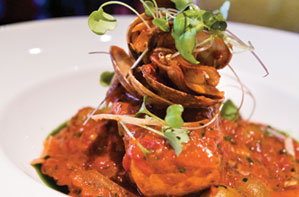To name a restaurant Saffron is to conjure associations of the rare and precious. Like natural pearls and golden caviar, saffron is expensive—about $150 an ounce.
But the name also is an apt signifier of Mediterranean cuisines. A few diligent farmers in Pennsylvania have managed to cultivate saffron, but the vast majority (and the finest grade) comes from the Mediterranean, where clay-rich soil and generous rainfall create the perfect environment. That’s why brothers Saed and Sameh Wadi—born in Kuwait of Palestinian descent and displaced to the United States by the first Gulf War—chose the name Saffron when they opened their restaurant in 2007.
“Every country we draw from uses saffron one way or another,” says Sameh, executive chef at Saffron.
Extracted from the stigmas of the flower Crocus Sativus, saffron has a vibrant red color that lightens to orangey yellow when cooked. It tastes like bitter oil, red pepper, and fresh meadow grass. It’s been used historically as a hangover cure, a poison, an aphrodisiac, and a digestive.
The Wadi brothers use it in roughly half the items on their monthly-changing menu, a fusion of North African, Spanish, and Middle Eastern cuisine. Saffron serves tagine, tabbouleh, and bisteeya but mixes ingredients from different regions: A dish traditionally made with lamb might use tuna steak; a Hudson Valley foie gras will be topped with medjool dates.
For those who simply love the spice, certain saffron-tinged items are always available. The Saffron Rose martini, for instance: a blend of Sapphire gin, orange blossom water, saffron, and sparkling rosé that is pleasantly bitter, bubbly, and fruity but not sweet.
The most popular entrée—and my favorite of all the wonderful things I tried—is the salmon and clam tagine, which Saed, who manages the restaurant, assures will remain on the menu for as long as customers continue to request it. There’s something bouillabaisse-like about the combination of fish and other seafood, but it sits on a bed of olives, peppers, fennel, and potatoes with a scant saffron broth.
And somehow in this dish, the bitterness of the saffron softens. It blends with the juices and loses its strong edges to become smooth, savory, and rich.
Saffron Restaurant & Lounge
612–746–5533
saffronmpls.com
123 N. 3rd St.
Minneapolis
• Loring Park gets a new restaurant in August when Birch’s of Long Lake opens a second location in the redeveloped Eitel Hospital building, now the Eitel Building Apartments. The restaurant and bar will feature a four-season patio overlooking the park.
• The former J. P.’s American Bistro site on Lyndale Avenue South in Minneapolis is being redeveloped by first-time restaurateur Gene Suh. No name for the place yet in early June, but it will open in late August. It and the Birch’s project are both being designed by Minneapolis-based Shea, Inc.
—Denise Logeland






